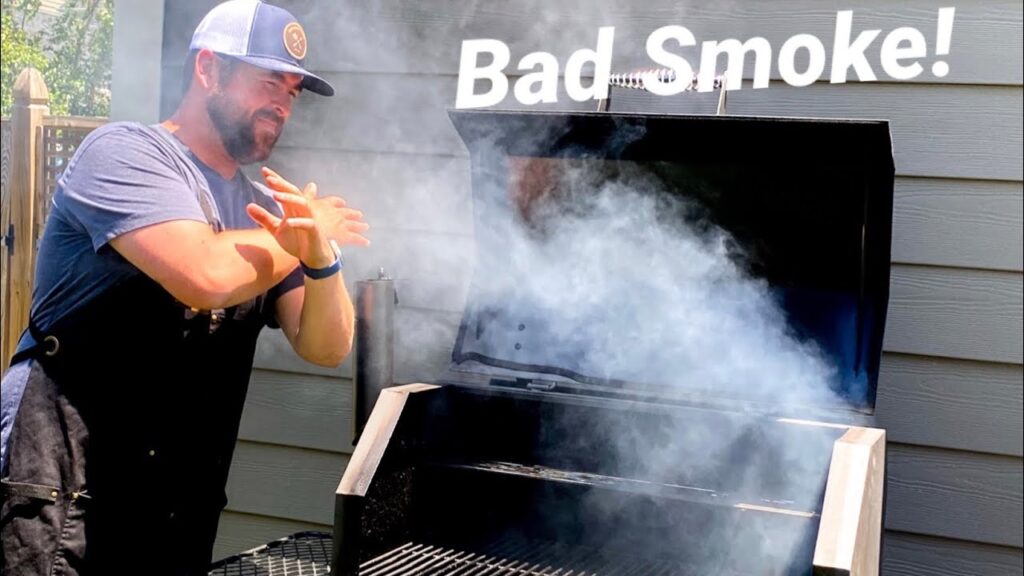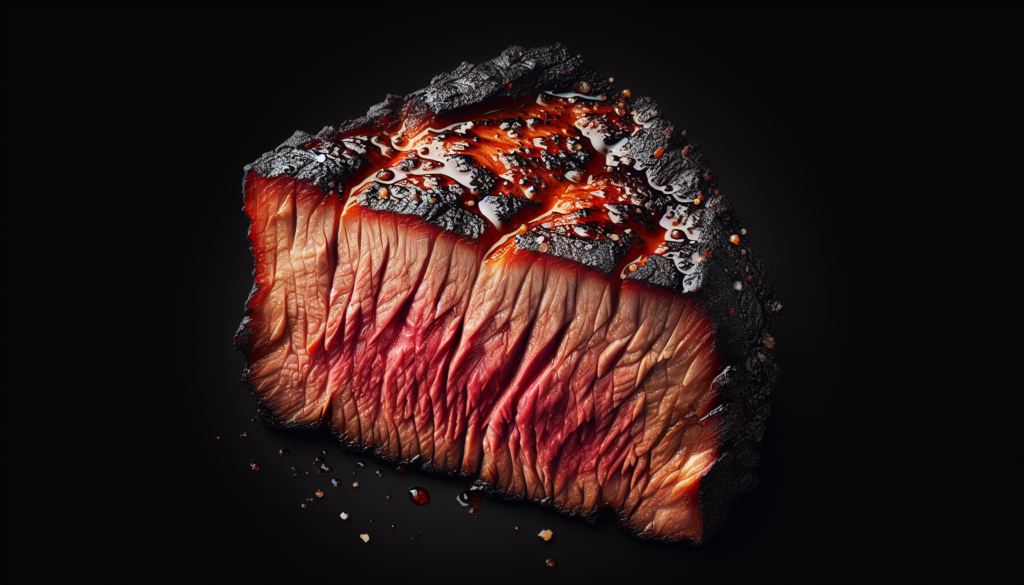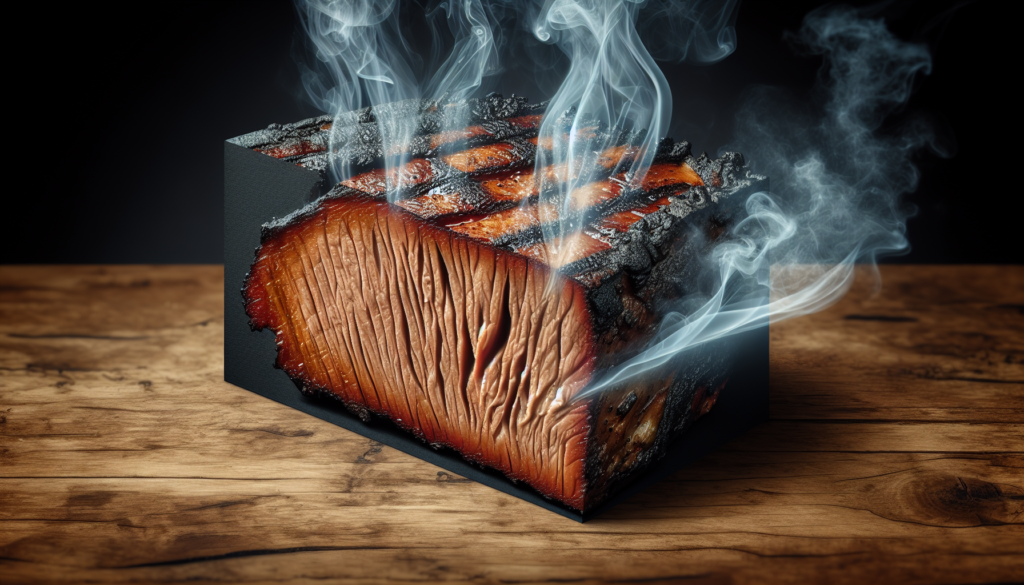Hey there! In this article, “Why BBQ White Smoke is Undesirable and How to Achieve Cleaner Smoke for Better Flavor,” we’re going to delve into the issue of BBQ white smoke and why it’s not the best for your barbecue. We’ll also provide you with some valuable tips on how to achieve cleaner smoke that will enhance the flavor of your food. Throughout the article, we’ll emphasize the importance of having a proper fire with enough oxygen, using smaller splits of wood, and controlling the amount of fuel. We’ll even touch on the use of premium lump charcoal for a better taste, while acknowledging the affordability and effectiveness of briquettes. From beginners to experienced grill masters, this article has something for everyone. So let’s jump right in and discover how to achieve that perfect smoke for a mouthwatering barbecue!

This image is property of i.ytimg.com.
The Problem with BBQ White Smoke
Understanding the issue
When it comes to barbecuing, many beginners mistakenly believe that heavy white smoke is desirable. However, this couldn’t be further from the truth. In reality, white smoke can have negative effects on the flavor of your food and even pose potential health risks. It’s important to understand the reasons behind the presence of BBQ white smoke to avoid these issues and achieve a better barbecuing experience.
Negative effects on flavor
One of the main problems with white smoke is that it can result in off-flavored food. The heavy white smoke contains excessive amounts of soot and other impurities that can settle on your food, giving it a bitter and unpleasant taste. Instead of enhancing the natural flavors of your meat, white smoke can overpower them and leave you with a less enjoyable eating experience. This is why achieving cleaner smoke is essential for obtaining the best flavor in your BBQ dishes.
Potential health risks
In addition to affecting the taste of your food, BBQ white smoke can also pose potential health risks. The soot and other particles present in the smoke can be inhaled and irritate your respiratory system. Prolonged exposure to these harmful substances can lead to respiratory issues and other health problems. By understanding the importance of clean smoke and taking steps to achieve it, you can significantly reduce these risks and ensure a safer barbecuing environment.
The Importance of Clean Smoke for Better Flavor
Enhancing the taste of your BBQ
Clean smoke plays a crucial role in enhancing the taste of your BBQ dishes. When the smoke is free from impurities and excessive soot, it allows the natural flavors of the meat to shine through. The clean and subtle smoky undertones add depth and complexity to the food, resulting in a more enjoyable and satisfying eating experience. By focusing on achieving cleaner smoke, you can take your BBQ game to the next level and impress your friends and family with deliciously flavored dishes.
Avoiding overpowering smoky flavors
Another benefit of clean smoke is that it helps avoid overpowering smoky flavors. With white smoke, the intensity of the smoke can be too strong and overpower the other flavors in your BBQ dishes. This can make it difficult to appreciate the nuances of different seasonings and marinades you may have used. By striving for cleaner smoke, you can strike the perfect balance between the smokiness and the other components of your dish, resulting in a more enjoyable and harmonious flavor profile.
Achieving a more balanced flavor profile
Clean smoke allows you to achieve a more balanced flavor profile in your BBQ dishes. Instead of relying solely on the smokiness to provide flavor, a cleaner smoke allows the other elements of your dish, such as the rubs, marinades, and spices, to shine through. This creates a harmonious blend of flavors that complement each other, resulting in a more well-rounded and satisfying eating experience. By paying attention to the quality of smoke you produce, you can achieve a more nuanced and balanced flavor in your BBQ creations.
Achieving Cleaner Smoke: Tips and Techniques
Proper fire management
Proper fire management is key to achieving cleaner smoke. It’s important to ensure that your fire has enough oxygen to burn efficiently and produce clean smoke. Make sure to open the air vents on your smoker or grill to allow for proper air circulation. This will help prevent the buildup of soot and other impurities that can contribute to white smoke.
Using smaller splits of wood
Using smaller splits of wood can also help in achieving cleaner smoke. Large pieces of wood can produce more smoke, including white smoke, due to incomplete combustion. By using smaller splits, you allow for more efficient burning, resulting in cleaner smoke and a better flavor profile in your BBQ dishes.
Controlling the amount of fuel
Controlling the amount of fuel you use can also contribute to cleaner smoke. Overloading your firebox with fuel can lead to excessive smoke production. It’s important to find the right balance and only use the amount of fuel necessary to maintain a steady cooking temperature. By carefully managing your fuel, you can minimize the production of white smoke and achieve cleaner, more flavorful smoke.
Importance of oxygen flow
Proper oxygen flow is crucial for achieving cleaner smoke. Ensuring that there is sufficient airflow in your smoker or grill helps promote complete combustion and reduces the likelihood of white smoke. Make sure to adjust the air vents accordingly to maintain optimal oxygen flow throughout the cooking process.
Choosing the right charcoal
The type of charcoal you use can also affect the quality of smoke produced. While premium lump charcoal is known to provide a better flavor and cleaner smoke, it may not always be necessary. Briquettes can also be effective and more affordable options. Experiment with different types of charcoal to find the one that works best for you in terms of flavor and smoke production.
Benefits of premium lump charcoal
If you’re looking to elevate your BBQ experience, investing in premium lump charcoal can be worthwhile. Premium lump charcoal is made from pure hardwood, which gives it a cleaner burn and produces less soot and ash. This results in cleaner smoke and a more authentic smoky flavor in your dishes. While it may be more expensive than briquettes, many BBQ enthusiasts consider it a worthwhile investment for achieving top-notch flavor.
Affordability and effectiveness of briquettes
On the other hand, briquettes can be a more affordable and effective option for achieving good smoke. They are made from compressed charcoal mixed with binders, which helps them burn consistently and produce cleaner smoke. Briquettes are readily available and can provide a reliable and convenient source of fuel for your BBQ. They may not offer the same depth of flavor as premium lump charcoal but can still produce excellent results.
Experimenting with Different Wood Types
Understanding the flavors of different woods
Wood plays a significant role in the flavor profile of your BBQ dishes. Different types of wood impart distinct flavors, ranging from mild and fruity to strong and bold. It’s essential to understand the characteristics of different woods and how they can enhance your BBQ creations. Some popular wood choices include hickory, mesquite, apple, cherry, and oak, each with its own unique flavor profile.
Choosing the right wood for your BBQ
When choosing wood for your BBQ, consider the type of meat you’re cooking and the flavor profile you want to achieve. For example, hickory is known for its strong and smoky flavor, making it suitable for heartier meats like beef and pork. On the other hand, fruitwoods like apple and cherry can add a subtle and sweet flavor that pairs well with poultry and seafood. Experimenting with different wood types will allow you to discover your preferred combinations and create more complex and flavorful BBQ dishes.
Combining different wood types for complexity
To add complexity to your BBQ dishes, consider combining different wood types. By combining woods with complementary flavors, you can create unique and multidimensional tastes. For example, combining hickory and apple wood can provide a balance of robust smokiness and subtle sweetness. Don’t be afraid to get creative and experiment with different wood combinations to find the flavor profiles that best suit your preferences.

Maintaining and Cleaning Your BBQ for Optimal Smoke
Regular maintenance and cleaning practices
Maintaining and cleaning your BBQ equipment is essential for optimal smoke production. Regularly inspect your smoker or grill for any debris or buildup that can obstruct airflow and contribute to the production of white smoke. Clean the cooking grates, firebox, and vents to ensure they are free from grease and ash. By keeping your equipment clean, you can achieve better air circulation and avoid any potential issues that may affect the quality of smoke.
Removing ash and buildup
One common issue that hampers smoke production is the accumulation of ash and buildup in your smoker or grill. This buildup can restrict airflow and lead to the production of white smoke. It’s important to remove ash and clean out any debris from the firebox and ash pan regularly. This ensures proper airflow and reduces the likelihood of unwanted smoke.
Preventing flare-ups and excessive smoke
Flare-ups and excessive smoke can occur when fat and marinades drip onto the hot coals or flames. These flare-ups can produce undesirable white smoke and affect the flavor of your food. To prevent this, consider using a drip pan or foil to catch any drippings. Additionally, avoid overcrowding the grill or smoker to minimize the chances of flare-ups. By taking these precautions, you can maintain a cleaner smoke and ensure the best flavor in your BBQ dishes.
The Importance of Temperature Control
Effects of temperature on smoke production
Temperature plays a crucial role in smoke production during BBQ. Different temperature ranges result in different qualities of smoke. Lower temperatures tend to produce thinner, bluish smoke, while higher temperatures can generate thicker and whiter smoke. To achieve cleaner smoke, it’s essential to maintain a consistent and controlled temperature throughout the cooking process.
Maintaining a consistent temperature
Maintaining a consistent cooking temperature is key to achieving cleaner smoke. Fluctuations in temperature can affect the combustion process and lead to the production of undesirable smoke. Use a reliable thermometer to monitor the temperature and make any necessary adjustments to maintain consistency. This will help you achieve optimal smoke production and avoid the pitfalls of white smoke.
Using air vents to control oxygen flow
Air vents are crucial for controlling oxygen flow and achieving cleaner smoke. By adjusting the air vents, you can regulate the amount of air that reaches the fire, which in turn affects the combustion process. Opening the vents allows for more oxygen and hotter temperatures, while closing them limits oxygen and lowers the temperature. Properly managing the air vents ensures a steady and controlled burn, resulting in cleaner smoke and better flavor in your BBQ dishes.

Experimenting with Wood Chunks and Chips
Benefits of using wood chunks and chips
Using wood chunks or chips can add a unique and intense smoky flavor to your BBQ dishes. These smaller pieces of wood can be added directly to the fire or used in a smoking box to infuse your food with delicious smokiness. Wood chunks and chips are available in various flavors, allowing you to experiment and find the perfect combination for your desired taste. They are particularly useful for shorter cooking times or when you want to add a burst of smoky flavor to your dishes.
Soaking vs dry wood
There is some debate regarding soaking wood chunks or chips before using them in BBQ. While soaking can help prolong the smoking process by slowing down the burn rate, it may also reduce the smoky flavor imparted by the wood. Dry wood tends to burn faster, producing more intense smoke and adding a stronger flavor to your dishes. Ultimately, the decision to soak or use dry wood depends on personal preference and the specific cooking needs of each BBQ session.
Placement and timing for optimal smoke
When using wood chunks or chips, proper placement and timing are essential for optimal smoke production. Place the wood near the heat source but not directly on the coals to allow it to smolder and release smoke gradually. Adding wood too early in the cooking process can result in excessive smoke, while adding it too late may not infuse the food with enough smoky flavor. Experimentation and adjusting the timing based on your desired results will help you achieve the perfect amount of smoke.
Monitoring and Adjusting Smoke Levels
Observing smoke color and density
Monitoring the color and density of smoke can provide valuable insights into the quality of smoke produced. Thin, bluish smoke indicates a clean burn and desirable smoke, while thick, white smoke suggests incomplete combustion and the presence of impurities. Regularly observe the smoke coming out of your smoker or grill and make adjustments as needed to achieve cleaner smoke.
Making adjustments based on observation
Based on your observations, you can make adjustments to achieve cleaner smoke. If the smoke is too thick and white, you can try opening the air vents to allow for increased oxygen flow. If the smoke is thin and bluish, you can adjust the fuel or wood placement to maintain the desired smoke levels. The key is to be attentive and responsive to the smoke characteristics throughout the cooking process to ensure the best flavor in your BBQ dishes.
Avoiding excessive smoke
Excessive smoke can negatively impact the flavor of your BBQ dishes, so it’s important to avoid it. While smoke is an essential component of barbecuing, too much smoke can overpower the other flavors and result in off-flavored food. By following the tips and techniques mentioned earlier, such as proper fire management, using smaller wood splits, and monitoring smoke color, you can avoid excessive smoke and achieve cleaner, more enjoyable BBQ results.
Tips and Advice for Beginners
Start with small amounts of wood
For beginners, it’s recommended to start with smaller amounts of wood to avoid producing excessive smoke. As you gain more experience and become familiar with the process, you can gradually increase the amount of wood to achieve your desired level of smokiness. Starting with smaller wood splits allows for better control over the smoke production and ensures a more balanced flavor profile in your BBQ dishes.
Practice patience and avoid rushing
Patience is essential when it comes to BBQ. Rushing the cooking process or trying to achieve intense smoke flavor too quickly can result in subpar results. Take the time to properly manage your fire, monitor the temperature, and adjust the smoke as needed. Good BBQ takes time, so be patient and allow the flavors to develop gradually. The end result will be well worth the wait.
Seek advice from experienced BBQers
Don’t hesitate to seek advice from experienced BBQ enthusiasts. Join online forums or local BBQ groups to learn from others who have mastered the art of smoke control and flavor enhancement. Ask questions, share your challenges, and be open to trying new techniques and recipes. The BBQ community is known for its camaraderie, and seasoned BBQers are often eager to share their knowledge and help beginners succeed.
Conclusion
Achieving cleaner smoke is vital for enhancing the flavor of your BBQ dishes and creating a more enjoyable eating experience. By understanding the issues associated with BBQ white smoke and implementing the tips and techniques shared in this article, you can take your barbecuing skills to new heights. Whether it’s through proper fire management, using the right wood and charcoal, maintaining temperature control, or experimenting with different techniques, your efforts in achieving cleaner smoke will be rewarded with delicious and perfectly flavored BBQ creations. So, fire up your grill or smoker, follow these guidelines, and get ready to impress your friends and family with mouthwatering, smoke-infused dishes. Happy barbecuing!
